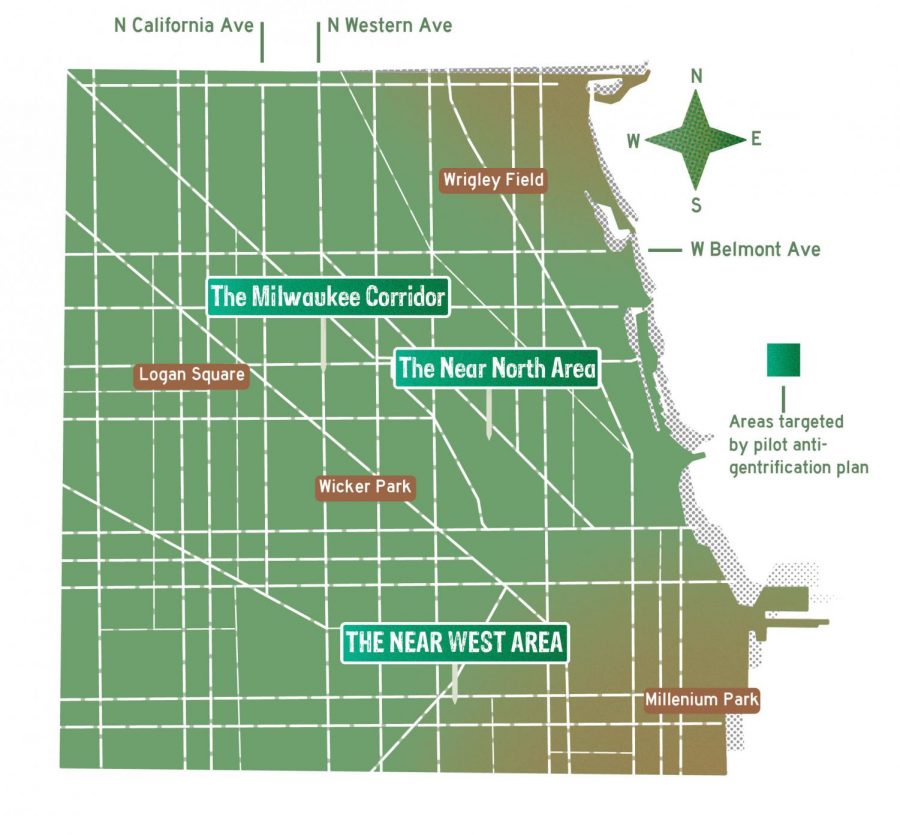Emanuel’s anti-gentrification plan may not be enough to stop displacement
Emanuel’s anti-gentrification plan may not be enough to stop displacement
September 25, 2017
Gentrification in Chicago placed many longtime residents from affected neighborhoods and has drained the affordable housing pool, but a new pilot program from Mayor Rahm Emanuel is designed to change that.
The initiative, announced at a Sept. 6 City Council meeting, lays out new affordability requirements for development projects in the statistically gentrified Near North, Near West and Northwest sides.
The initiative continues the work of the 2015 Affordable Requirements Ordinance, which required developments receiving financial assistance from the city or involving city-owned land to incorporate affordable housing into 10 percent of the building or pay a fee up to $225,000.
The new, tougher rules will no longer allow developments to opt out by paying the fee, according to an Aug. 25 press release from the mayor’s office.
Steadily rising housing costs have made the need for more affordable housing critical, according to neighborhood advocates.
“To afford an apartment in Chicago, that means an individual has to work two full-time minimum-wage jobs,” said James Rudyk, executive director for the Northwest Side Housing Center. “It’s just not realistic.”
The pilot’s targeted Milwaukee Corridor area— including the areas of Logan Square, Avondale and West Town— covers approximately nine square miles and raises the ARO unit obligation to 20 percent for developers building off-site within the pilot area. While Rudyk said the 20 percent requirement is a “step in the right direction,” it will only generate a hypothetical 24 units in a 120-unit development—which is insufficient, especially for the growing number of people who cannot afford the area and do not have a home or place to rent, he added.
The pilot program lacks a holistic plan to prevent displacement throughout the city, said Juan Carlos Linares, executive director for Latin United Community Housing Association, which promotes housing as a human right for low-income individuals.
“[There are] very disinvested areas where people are leaving because of crime and violence, and we see this reflected in the diminishing demographics, particularly in African-American neighborhoods,” Linares said. “There’s no holistic plan to give dignity and respect to that issue.”
In the Near West zones, developers who do not want to build affordable units within the buildings can opt to build affordable housing off-site in the pilot area—but one-third of the units set to the tune of 100 percent of the average median income for a Chicago household family of four, $79,000 . In comparison, the AMI for a four person-family in Logan Square is about $40,000.
“So who are we replacing these units for?” Linares said. “We’re mandating developers to complete and execute on affordable housing in these pilot areas, but if we’re looking at 80 or 100 percent [of the AMI], that’s not the [type of] person we currently serve.”
Linares—whose organization helps residents specifically in the Humboldt Park, West Town and Logan Square areas—said he welcomes the 606 trail, a 2.7 mile-long park on abandoned train tracks that runs through Bucktown, Wicker Park, Logan Square and Humboldt Park and opened in June 2015. However, data shows organization’s own assessed property values started rising at accelerated rates, he said.
“[We] celebrate the 606 and what it means but also want the residents who have been here for many years to also take advantage of it without being priced out because of taxes,” he said.
Logan Square’s amenities of good, accessible public transportation, new businesses, entertainment and safety signals to people of an “elevated” economic status that it is a good neighborhood to live in, said Justine Bayod-Espoz, longtime Logan Square resident and spokesperson for Somos Logan Square—a volunteer organization that raises awareness about inequality, neighborhood development and resident rights in the neighborhood.
“What we’re seeing is that the people that have lived in this neighborhood and have made this neighborhood and have raised their families in this neighborhood are now being forced to leave because people with more money can afford to come buy [here],” she said.
Rudyk said he has seen displaced Logan Square, Hermosa, Avondale, Humboldt Park, Wicker Park and Bucktown residents move to the Belmont Cragin area, which his organization mainly works with. He noted that, from 2000 to 2010, Belmont Cragin’s AMI was cut in half because of low-income individuals’ influx into the area.
“[The city’s] population continues to decline at 1 or 2 percent overall, [but] our population continues to grow,” Rudyk said. “We have over 79,000 residents, [and people] continue to move into our area because of affordability [reasons]; we’re seeing the result of the gentrification.”
Linares said he saw the most naturally-occurring affordable housing units in the city—two-unit apartment buildings—converted into single family homes and sold for up to $1 million or torn down completely for a $500,000–$1 million home.
“This hurts everyone because once you have that million dollar home and the next $800,000 home down the street and [another] across the street [at] $500,000, everybody’s assessments are going to be raised because of the assessed values of those properties,” Linares said. “We’re not just talking about the poor, we’re talking about working class, moderate income individuals and families [being affected].”








